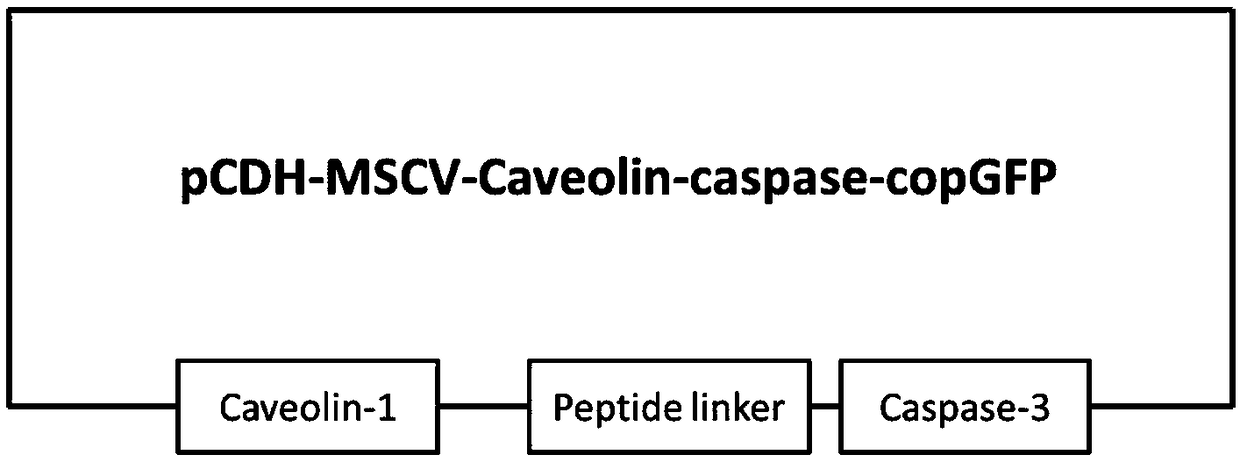Target cell TCC-3T3 for inspecting killing effect of TCR-T (T cell receptor T) cell as well as preparation method and application thereof
A technology of TCR-T and TCC-3T3, applied in the field of cell engineering, can solve the problems of inability to carry out long-term killing experiments, insensitive killing signals, and high killing background, so as to avoid non-specific killing, sensitive killing signals, and low killing background Effect
- Summary
- Abstract
- Description
- Claims
- Application Information
AI Technical Summary
Problems solved by technology
Method used
Image
Examples
preparation example Construction
[0033] The present invention also provides a method for preparing the target cell TCC-3T3, comprising the following steps: 1) connecting the Caveolin-1 gene and the caspase-3 gene with a connecting peptide to obtain the fusion protein gene of Caveolin-1 and caspase-3; 2. ) transfer the fusion protein gene of Caveolin-1 and caspase-3 into mouse fibroblast-like cells by lentiviral transfection method to obtain CC-3T3 cells expressing the fusion protein; 3) lentiviral transfection method TCR-T Cell target antigen gene and HLA gene were transferred into CC-3T3 cells to obtain target cell TCC-3T3.
[0034] In the present invention, the fusion protein gene of Caveolin-1 and caspase-3 is obtained by linking Caveolin-1 gene and caspase-3 gene with connecting peptide; Methods: Caveolin-1 gene, connecting peptide gene and caspase-3 gene connected in sequence were synthesized as a fusion gene.
[0035] In the present invention, after the fusion protein gene of Caveolin-1 and caspase-3 is ...
Embodiment 1
[0047] 1. Construction of lentiviral transfection experiment
[0048] (1) Recovery culture HEK-293T ( CRL-11268 TM ), pass on 1-2 generations. Cells were collected and counted the day before transfection, diluted to 5 × 10 5 After the cells / mL, spread 20mL onto a 15cm Petri dish and place it in a 37°C, 5% CO2 incubator for culture.
[0049] (2) On the day of transfection, take two 15mL centrifuge tubes and add plasmids and reagents according to Table 1.
[0050] Table 1 Reagents for transfection
[0051]
[0052] (3) Stand at room temperature for 5 minutes.
[0053] (4) Transfer the liquid from tube A to tube B and mix well.
[0054] (5) Stand still at room temperature for 20 minutes.
[0055] (6) Cell replacement: use a pipette to suck out the culture medium, add 10mL DMEM, shake gently, and then suck it up. Add 18mL DMEM to the Petri dish, shake it gently and place it at 37°C with 5% CO2 for culture.
[0056] (7) Pipette the mixture of tubes A and B with a 5mL p...
Embodiment 2
[0096] The TCR-T cell target antigen gene was replaced by the MAGE-A3 gene, and the rest of the steps were consistent with Example 1.
[0097] The result is as Figure 7 As shown, NIH / 3T3 is a cell without genetic modification; CC-3T3 is a cell stably transfected with fusion genes of Caveolin-1 and caspase-3; TCC-3T3 is a cell stably transfected with fusion genes of Caveolin-1 and caspase-3 and HLA-A0201α chain and β2M gene; TCC-3T3-MAGE-A3 is a cell stably transfected with Caveolin-1 and caspase-3 fusion gene, HLA-A0201α chain, β2M gene and MAGE-A3 gene. NTC is untransfected PBMC cells targeting MAGE-A3 TCR; DMF4 is transfected PBMC cells targeting TCR recognizing MAGE-A3 antigen, and DMF4 recognizes MAGE-A3 antigen dependent on HLA-A0201 presentation.
[0098] TCR-T cells can recognize and kill target cells TCC-3T3 with MAGE-A3 gene antigen, but have no killing effect on CC-3T3 cells and NIH / 3T3 cells that do not have MAGE-A3 gene antigen. And NTC cells did not kill TCC-3T...
PUM
 Login to View More
Login to View More Abstract
Description
Claims
Application Information
 Login to View More
Login to View More - R&D
- Intellectual Property
- Life Sciences
- Materials
- Tech Scout
- Unparalleled Data Quality
- Higher Quality Content
- 60% Fewer Hallucinations
Browse by: Latest US Patents, China's latest patents, Technical Efficacy Thesaurus, Application Domain, Technology Topic, Popular Technical Reports.
© 2025 PatSnap. All rights reserved.Legal|Privacy policy|Modern Slavery Act Transparency Statement|Sitemap|About US| Contact US: help@patsnap.com



